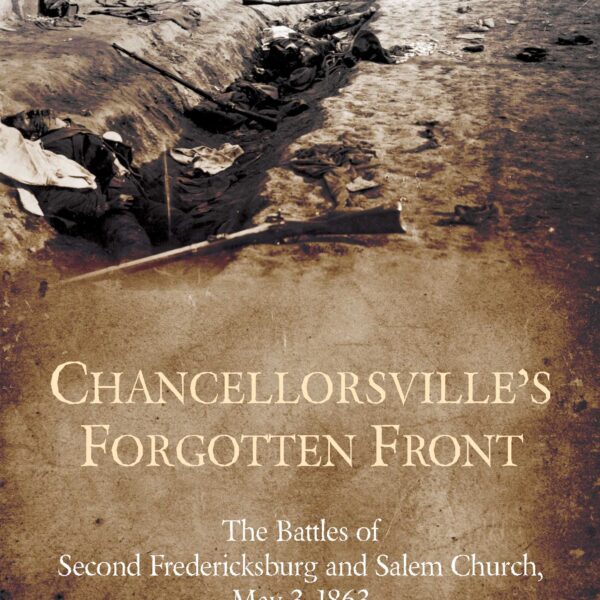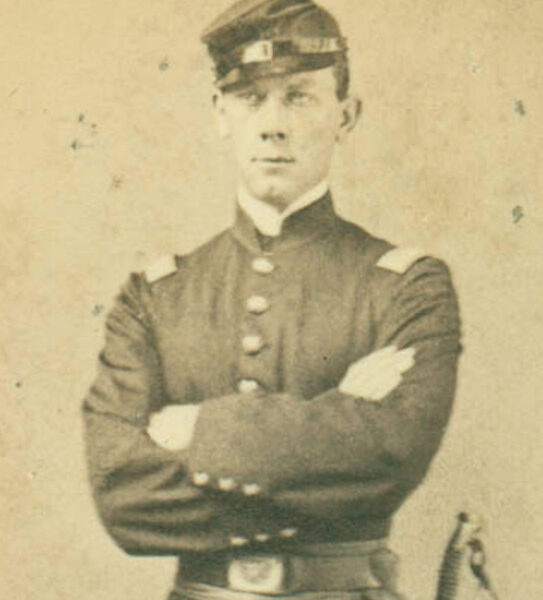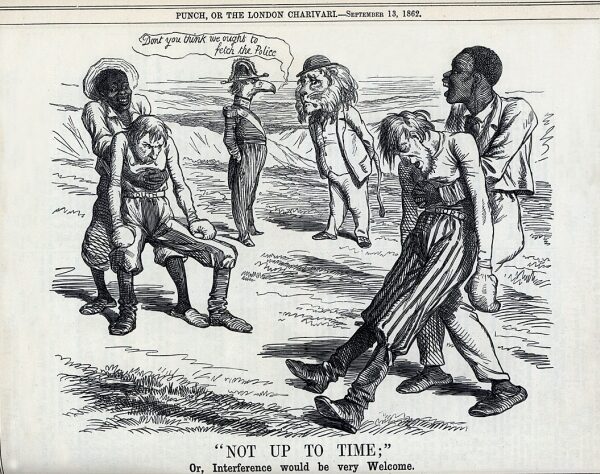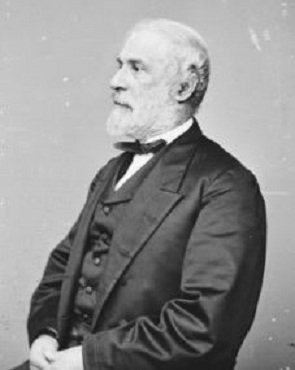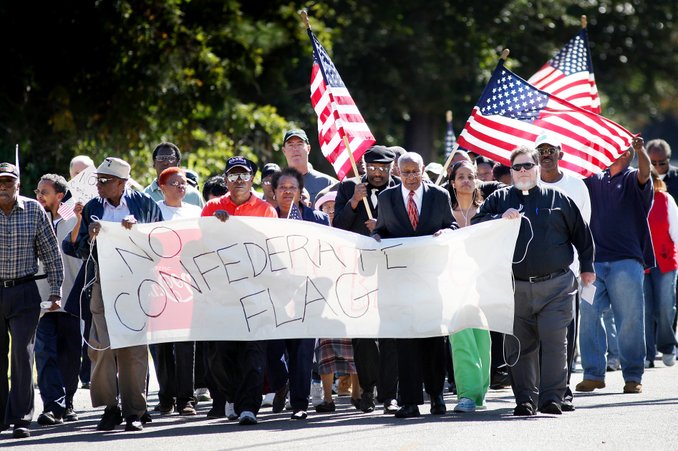
Several news stories appeared in the media recently updating recent developments in a neighborhood dispute in South Carolina that’s been brewing for about year now. The brief recap is that a white woman, Annie Chambers Caddell, moved into the historically African American neighborhood of Brownsville, an formerly-unincorporated area now part of the city of Summerville.
Caddell counts a number of Confederates among her ancestors, and hung a Confederate Battle Flag on the front of her house. Inevitably there were protests against Caddell, and counter-protests featuring the usual parade of characters. The neighbors brought in the NAACP to help organize a protest march; the secessionist South Carolina League of the South brought in their own protestors to stand with Caddell. It got worse; someone reportedly threw a rock at Caddell’s house. (Some reports say it was onto the porch, others say it was through a window. Either way, that particular act is inexcusable.) There has been inflammatory, over-the-top rhetoric on both sides. Not surprisingly, both sides have chosen to escalate the dispute:
Earlier this year, two solid 8-foot high wooden fences were built on either side of Annie Chambers Caddell’s modest brick house to shield the Southern banner from view.
Late this summer, Caddell raised a flagpole higher than the fences to display the flag. Then a similar pole with an American flag was placed across the fence in the yard of neighbor Patterson James, who is black. . . .
“I’m here to stay. I didn’t back down and because I didn’t cower the neighbors say I’m the lady who loves her flag and loves her heritage,” said the 51-year old Caddell who moved into the historically black Brownsville neighborhood in the summer of 2010. Her ancestors fought for the Confederacy.
Last October, about 70 people marched in the street and sang civil rights songs to protest the flag, while about 30 others stood in Caddell’s yard waving the Confederate flag.
Opponents of the flag earlier gathered 200 names on a protest petition and took their case to a town council meeting where Caddell tearfully testified that she’s not a racist. Local officials have said she has the right to fly the flag, while her neighbors have the right to protest. And build fences.
“Things seemed to quiet down and then the fences started,” Caddell said. “I didn’t know anything about it until they were putting down the postholes and threw it together in less than a day.”
Aaron Brown, the town councilman whose district includes Brownsville, said neighbors raised money for the fences.
“The community met and talked about the situation,” he said. “Somebody suggested that what we should do is just go ahead and put the fences up and that way somebody would have to stand directly in front of the house to see the flag and that would mediate the flag’s influence.”
Caddell isn’t bothered by the fences and said they even seem to draw more attention to her house.
“People driving by here because of the privacy fences, they tend to slow down,” she said. “If the objective was to block my house from view, they didn’t succeed very well.”
None of this is surprising. At all. In fact, it follows a pretty standard script of confrontation we’ve seen over and over again, in disputes involving Confederate symbols. It’s tiresome, it’s counterproductive, and it’s ugly. It makes what could be taken by the neighbors as an annoying one-off—deeply offensive, but isolated—an increasingly toxic focus of frustration. For her part, Ms. Caddell could have remembered her ancestors any number of ways, but chose the method she knew would offend her new neighbors. As one commenter on Ta-Nehisi Coates’ blog at The Atlantic suggested, Caddell effectively gave her neighbors the finger.
No one, including her critics, question Ms. Caddell’s right to display the Confederate flag on her own property. Neither does anyone question the neighbors’ right to protest that display in any peaceable way they choose. But sometimes folks get so caught up in defending their rights, that they lose sight of what is right, either for themselves or those around them.
There is one thing that makes this particular dispute unusual, though. Brownsville is not only an historically African American community, it was actually founded by former U.S. Colored Troops after the war:
Among [Brownsville’s] founding families were at least 10 soldiers stationed to guard the Summerville railroad station at the close of the Civil War. They were members of the 1st Regiment, United States Colored Troops, part of a force of freedmen and runaway slaves who made history with their service and paved the way for African Americans in the military.
At least some of the men were from North Carolina plantations. When the war ended they stayed where they were, living within hailing distance of each other along the tracks. Some of them lived on the “old back road” out of town where outrage has erupted recently over a resident flying a Confederate battle flag. Their ancestors [sic., descendants] still live there.
It’s a striking note in a controversy over heritage that has raised hackles across the Lowcountry and the state.
The community’s past is an obscure bit of the rich history in Summerville, maybe partly because for years the families kept it to themselves. They were the veterans and descendants of Union troops, living through Jim Crow and segregated times in a region that vaunted its rebel past.
The great-great-grandfather of Jordan Simmons III was among them. But growing up in Brownsville a century later, all Simmons remembers hearing about Jordan Swindel, his ancestor, is that he was a runaway slave who joined the Army. The rest, he says simply, “was not talked about.” He didn’t find out about it until he was an adult doing research on the Civil War and the troops and came across Swindel’s name. . . .
It overwhelmed him to see his great-great-grandfather’s name on the wall of honor three years ago when he visited the African-American Civil War Memorial in Washington, D.C. Pvt. Swindel fought in four battles in nine months in 1864, from Florida—where he was wounded—to Honey Hill, S.C. Simmons wishes he would have sought out that history when he was younger.
The historical circumstances surrounding the town’s founding don’t change the core legal issues at hand, but given that Confederate heritage folks routinely dismiss criticism of the Confederate Flag as uninformed, knee-jerk “political correctness,” or as unfairly tarnishing an honored symbol of the Confederacy with its use by hate groups, it’s interesting to see a case where the protestor’s case against the flag is so explicitly based in the very same “heritage” argument that the flag’s proponents righteously embrace. For at least some local residents, pushback against the CBF is every bit as grounded in the history of the American Civil War, and honoring one’s ancestors, as Ms. Caddell’s display of it. For them, it’s personal, and for exactly the same reasons.
I don’t know what the answer here is. Each side has dug in its heels, to the point that neither side can made a concession without the other trumpeting that as a victory. As in so many other cases, all that remains, really, is bitterness and animosity. What is clear, though, is that there’s an historical dimension to this case—very real and very valid, by the same “heritage” standard that the folks in (say) the South Carolina League of the South embrace for themselves—that needs much wider dissemination, and it plays a big role in how that community thinks and feels and reacts.
Andy Hall is a Texan and Southerner by birth, residence and lineage, with a family tree full of butternuts. With a background in history, museum studies and marine archaeology, Hall also writes at his own blog, Dead Confederates.
Photo Credit: The Post and Courier.

